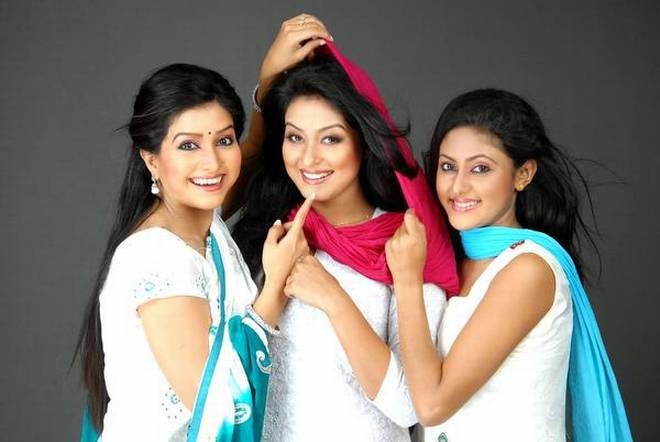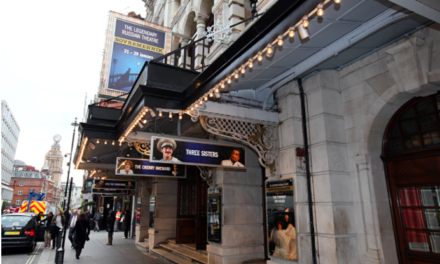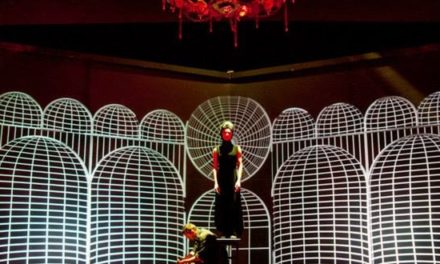It’s a little over a month into mobile theatre season in Assam, and a surplus of professional touring companies in the region have already begun to unleash their particular brand of “massy” stage extravaganzas on rural and urban audiences alike. The circuit, which will run till mid-April next year, is locally known as bhramyaman theatre. Traveling from post to outpost with the gumption of a traveling circus replete with large troupes of actors, costumes, props, and backstage paraphernalia, the companies stage epics and spectacles that have earned the otherwise unassuming town of Pathsala in Barpeta, home to many of the groups, the sobriquet of being the Hollywood of Assam. And true to that reputation, not only has the idiom of mainstream cinema been embraced wholeheartedly by the touring productions, but the local film industry, struggling with poor box office receipts, has also been supplanted somewhat by hugely popular plays that mimic their sensibility and style.
Reminiscent of cinema
The publicity art might be reminiscent of B-cinema hoardings, and the acting might hark back to the melodrama of the 1980s, but the whirring machinery of miraculous stagecraft on display, with its “old cinema” smoke and mirrors aesthetics, announces mobile theatre as a genre that is both confounding and illuminating. Many productions follow the format of the standard issue “masala” film—with swashbuckling heroes, menacing villains, avenging angels and action sequences galore—but to recreate these tenets faithfully on stage for a paying public calls for an acute understanding of theatrical wherewithal, albeit one that has been harnessed to reproduce the faux-naturalism of “cinematic illusion.”
A case in point is Kohinoor Theatre’s now historic production of Titanic, based on the James Cameron blockbuster, which has become mobile theatre’s de facto calling card in the 15 odd years since it first opened in 2002. Of course, ever since its beginnings in the 1960s, bhramyaman theatre has been no stranger to large-scale spectacle, with a version of the Mahabharata proving to be particularly popular in the 1980s. It was a production that did not shy away from showcasing the war of Kurukshetra in all its gaudy military glory. Hemanta Dutta’s ambitious Titanic took on a love story that had proved its universal credentials to a rural populace who couldn’t afford to frequent cinemas. Each iconic scene in the original was recreated faithfully by local actors who held on to Anglicised names like Rose and Jack, even as the translation into colloquial Assamese brought immediate relatability to a plot set in alien waters. The sinking of the ship, operated on tracks, was a memorable stage moment well worth the price of admission.
Setting the stage
Apart from the trailblazing Kohinoor, several other groups have mounted successful companies that have exhibited both longevity and imagination. This year, the Hengool Theatre has announced three new productions for the eight-month-long season—Mahaveer (The Great Warrior), Bandookor Kobita (The Poetry Of The Gun) and Mirabai. In keeping with their derivative roots, each play is announced with the release of trailers and music tracks. Bhramyaman groups have rabbits jumping out of hats to outdo each other. Kohinoor recently announced the use of 3D technology for the opening credits of one of its productions, to strangely complement the all-dimensional appeal of live entertainment in which umpteen set changes are effected with the felicity of a jump cut.
Commercial theatre circuits in India are floundering and suffering, so the enduring success of Assamese mobile theatre in a world of small stakes but great returns is certainly of interest, although its resolutely populist fare can be a sore point for experimental theatre practitioners. More than anything, its reach allows us to understand the psyche of ordinary people with an appetite for custom-made local-style escapism, not hand-me-downs from mainland entertainment cultures. Much of Assam’s parallel theatre cultures—the late Sukracharya Rabha’s theatre of the roots, or the artistic traditions of the river-island of Majuli, or the commercial-minded city theatre–cover an anthropological grid of society.
Bhramyaman is relatively conservative, which stands in some contrast to the degenerate contemporary state in which other traditionally popular forms like North India’s nautanki and West Bengal’s jatra find themselves. Its sincerity of presentation allows each over-the-top production with its booming musical score and fire-and-brimstone performances to possess an integrity all of its own, and perhaps that is what explains the staying power of a mass form that has been pushed to near extinction almost everywhere else in the country.
This article first appeared in The Hindu on September 11, 2018, and has been reposted with permission.
This post was written by the author in their personal capacity.The opinions expressed in this article are the author’s own and do not reflect the view of The Theatre Times, their staff or collaborators.
This post was written by Vikram Phukan.
The views expressed here belong to the author and do not necessarily reflect our views and opinions.


















